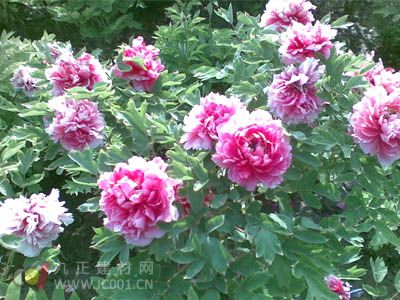Peony Introduction
Alias: Baihuawang, Pride Huawang, Luhan, Muxi Medicine, Kao, Luoyang Wang, Fuguihua. Common varieties include embroidered peach, Luhe red, Yexinghua, variable leaf wood, Xiaohuhong, Pingdinghong, Yingjinhong, Zhuangyuanhong, Jinqihong, Yingcuihong, Chaoyanghong, Jinhongsatin, Caozhouhong, Zihonglou, Silver beads, large petals red, jade face peach blossoms, white flowers fight spring, Baiyuan Hongxia, lotus peony, and full house hibiscus. Morphological characteristics: The plant typically grows to about 2 cm in height. It has erect branches that cluster at the rhizome, with smooth, yellow-brown stems. The leaves are alternate, pinnately compound, with lanceolate or egg-shaped leaflets. The upper surface of the leaves is dark green or yellow-green, while the underside is gray-green, smooth, and some varieties have fine hairs. Flowers appear at the top of the branches, and they come in a wide range of colors such as white, yellow, pink, red, purple, and even green. Peony propagation methods include several effective techniques. First, the ramet method is commonly used in autumn. Select a healthy mother plant aged 4–5 years. Carefully remove the soil from the roots and divide the plant according to the branches, buds, and roots. After opening the mother plant, soak the cut surfaces in a carbendazim solution for sterilization before planting in suitable soil. The grafting method includes root grafting and branch grafting. The best time for rooting is around September. Strong, disease-free peony roots, about 25 cm long, are selected as rootstocks. After drying in a cool place for 2–3 days, they are grafted. Branch grafting can be done using two techniques: soil connection and abdominal grafting. Soil connection is usually performed around the autumn equinox. A peony rootstock is cut about 5 cm above the ground, and a scion is inserted into the rootstock, then covered with soil. Abdominal grafting is done between mid-July and mid-August, using strong sprouting branches as scions. The seeding method involves drying harvested fruits in a cool, ventilated area or indoors. When the seed coat turns black and the fruit opens naturally, the seeds are removed and sown after 2–3 days of drying. The bead method is typically carried out at the end of May and early June. Choose strong 2–3-year-old branches, make cuts on the current year's shoots, injure the bark slightly, press the branches down, and cover them with soil. Place stones or other weights on top to keep them in place. Keep the soil moist by watering regularly. After a year, when the roots are well developed, the new plants can be transplanted from the mother plant. Light and temperature: Peonies prefer cooler conditions, with an ideal growth temperature of 16–20°C. They are not very cold-resistant, so it’s important to protect them during harsh winters. Soil: Peonies thrive in loose, fertile, well-draining loam soil. Good drainage is essential to prevent root rot. Watering: These plants have deep fleshy roots and do not like excessive moisture. Water only when necessary, allowing the soil to dry slightly between waterings. Fertilization: When transplanting, use rich organic base fertilizer. In addition, apply three rounds of fertilizer annually: a diluted phosphate solution half a month before flowering, a compound fertilizer half a month after flowering, and compost applied at the end of autumn to nourish the plant for the next growing season. Buying tips: Look for plants with straight trunks and thick branches. It’s best to choose varieties that are resistant to pests and diseases to ensure better growth and longevity. ATEX Approved Coriolis Mass Flow Meter
Sealand is a trustworthy manufacturer of Mass Flow Meter Coriolis, Mass Flowmeter Coriolis, Flow Meter Coriolis and Meter Coriolis, ATEX, CE & IECEx approved.
The flow meter model covers from DN03 to DN150, and bigger models are being developed. Main specification is as follows.
Model No.
Diameter
(mm)
Max. flow rate
(kg/min)
MWP.
(MPa)
Accuracy grade
(%)
Zero stability
(kg/h)
CG-03
03
6
4
0.1/ 0.2/ 0.5
0.012
CG-06
06
18
4
0.1/ 0.2/ 0.5
0.04
CG-15
15
50
25
0.1/ 0.2/ 0.5
0.12
CNG-20
20
120
25
0.1/ 0.2/ 0.5
0.36
CG-25
25
200
4
0.1/ 0.2/ 0.5
0.62
CG-40
40
500
4
0.1/ 0.2/ 0.5
1.60
CG-50
50
1000
4
0.1/ 0.2/ 0.5
2.38
CG-80
80
3000
4
0.1/ 0.2/ 0.5
7.05
CG-100
100
3600
4
0.1/ 0.2/ 0.5
12.00
CG-150
150
8000
4
0.1/ 0.2/ 0.5
50.00
Mass Flow Meter Coriolis, Mass Flowmeter Coriolis, Flow Meter Coriolis, Meter Coriolis Zhejiang Sealand Technology Co., Ltd. , https://www.sealandflowmeter.com